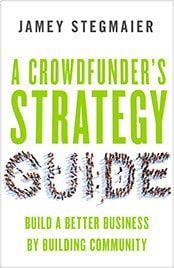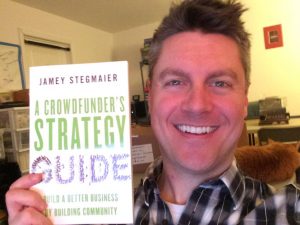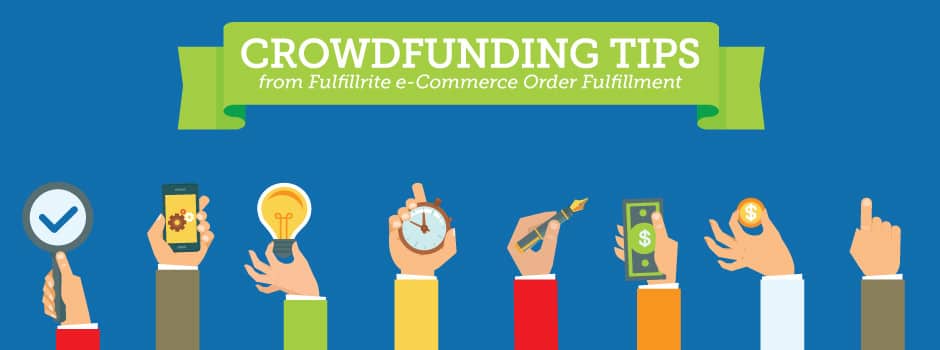“The crowd is the new gatekeeper.”
Maybe you’re thinking about running a crowdfunding campaign – where do you start? There are a hundred websites and guides which count down the steps to successful crowdfunding, but what about the abstracts, such as building community and engaging with them?
We sat down with veteran crowdfunder Jamey Stegmaier, head of Stonemaier Games and author of A Crowdfunder’s Strategy Guide: Build a Better Business by Building Community, to talk a little bit about his new book, social strategies and approaches and how communication – and community – is king.
Thank you for taking the time to chat about your book and answer some questions. Can you tell us a little bit about yourself?
Sure! My name is Jamey Stegmaier, and I’m the co-founder and president of Stonemaier Games. We make strategy games like Viticulture, Euphoria, and Between Two Cities. I also write a blog about crowdfunding—I’ve used Kickstarter to fund the first print run of all of our productions—at www.kickstarterlessons.com, and I wrote a book to help other creators called A Crowdfunder’s Strategy Guide: Build a Better Business by Building Community.
So, how did this book come about?

My crowdfunding blog—which I’ve written since funding Viticulture on Kickstarter in 2012—focused on tabletop game projects for a while, and most creators in that space are aware of it. But there are so many other things that people can create via crowdfunding! I was contacted by an agent who saw the potential for a book to reach a much wider audience and help more people than the blog, so I decided to write such a book.
Really, I just want to help other creators—those who are actively creating and those who want to create something, but need a little nudge. Also, I think the core principle in the book of putting other people first (which has a hugely positive impact on the long-term business) is a message worth sharing.
How did writing a non-fiction book differ from writing your blogs? Was it difficult to merge the two? It must have been pretty tricky running Stonemaier Games and writing the book at the same time.
It was different. While I try to write the blog in an accessible way, it’s very mechanical and step by step. I wanted the book to read more like a story. So at first I focused on my story, and over time I added more and more stories from other creators. I still borrowed a lot of my lessons learned for the book, though—they’re just expressed in a different way. And yes, it was tough to write the book and run the company at the same time! I can’t imagine doing that right now.
Your book is very comprehensive in the way that you present crowdfunding product categories in a general approach and not focused on your niche, which is games. In respect to games, do you think their increased popularity is a natural evolution or has crowdfunding played a bigger part?
I think crowdfunding has had a significant hand in the booming board game industry. It’s put games in front of millions of people who didn’t realize how popular games are. I think popularity gives us permission to do something we’ve always wanted to do, and most people like to play games (in some form—not necessarily board games). A Kickstarter page clearly conveys popularity—or lack thereof—to people who otherwise have no idea how a product sells.
“The crowd is the new gatekeeper.” Cultivating a community and keeping them active and engaged is a key point throughout the book and in fact, is possibly more important than the campaign itself. What would be the 3 most important avenues to pursue when just starting to build a community?

Exactly, you summed that up really well. Let’s see, 3 most important avenues:
- Have a platform. Whether it’s a blog, podcast, YouTube channel, Facebook page, and/or e-newsletter, start a platform and create some sort of content there at least once a week. This gives people a place to stay in touch with you after they discover you, and it might be the way many people discover you for the first time. Also, if people show up at your platform and engage with you, make sure you’re part of that conversation too. No one likes talking to a brick wall.
- Hang out where such communities already exist. Whether it’s online or in the real world, there are tons of communities for pretty much everything. Find the communities that are connected to the thing you’re trying to make and become a part of them.
- Be generous. The best way to attract people to you is to be generous with your time, talent, information, and money. Conversely, the best way to turn off people is to be purely self-serving and self-promotional.
You talk about one mistake you made with the Viticulture campaign was not building an active community within the board game category. Who DID you communicate with, who were you targeting?
That’s very true. In the board game space, there’s an amazing website called BoardGameGeek. I love board games, and I should have been involved on that site for a long time. But I wasn’t. However, those with whom I did communicate were bloggers, and that made a big difference on my first campaign.
“People don’t buy what you do, they buy why you do it.” Simon Simek – What are some signs of campaigns that are transparently not in it for the right reasons, insincere? Is this perception something that could be turned around?
This is a tricky question. I know the answer, but I don’t want to assume that the creators are purely in it for the “wrong” reasons. Basically, if your pledge levels aren’t compellingly and fairly priced, that’s a little bit of a red flag to me. Every creator has the right to make a profit, but there’s a fine line between profit and greed. So it’s not really about perception in this case—it’s about pricing.
Early-bird rewards: Your outlook regarding early-bird rewards is that it creates a winners/losers situation, but couldn’t it also portray that sense of urgency/building momentum also present in a campaign? Several recent highly successful runs offered them, such as the Baubax Travel Jacket and Nebia Showerhead.
Sure, plenty of successful campaigns have implemented strategies. That doesn’t make those strategies good, though. 🙂
Here’s the deal: A crowdfunding campaign is an early-bird reward. It’s a condensed amount of time during which a backer gets the best version of the thing at the best price. Imagine if there’s a campaign for an awesome thing that you really want, and you discover it the day after the campaign ends. It sucks, but the campaign was live for 30 days, and you missed it. So maybe you go to their website and pre-order the product at an extra expense. But imagine that you discover a campaign while it’s still live on Kickstarter, and it’s only the second day, but you already missed the best price? That really sucks. You’re just as much a part of the success of the project as someone who discovered it a few hours earlier, but you’re already paying more for it than they are. As a creator, I would never treat my backers that way. Instead of treating some backers better than others, I’d rather compel people to back the project on day one by creating something awesome, presenting it in an awesome way, and building a crowd in advance so we have a big launch day.
In the book, an anecdote is presented about lines to get into a restaurant. One has no line, the other one a line around the block; which do you judge as being more popular? In that respect, can the sense of urgency also translate into the image of popularity?
I think this goes back to what I was saying about crowdfunding being a way to show non-gamers that a lot of people are actually buying and playing games. If you discover a project that’s raised $200,000 from 5,000 people, it’s going to catch your eye a lot more than a project that is 7% funded with 52 people. As for urgency, I think the limited timeframe of a project plays a role in inspiring people to support a project right away instead of waiting.
When involving the backer community in open discussion about feedback, changing features, etc., do you feel it’s necessary to deliberately plan for changes to your product along the way, working a buffer into the budget?
Absolutely. Building a buffer into your budget is never a bad thing, because you’ll almost always need it. As for the involving the backer community in the design process—thus building a strong, loyal fan base and a better product along the way—I think the key is to launch the project with a 95% finished product, and leverage the crowd to complete that final 5%. Just make sure you know what that 5% is, because once the crowd starts to pick away at the 95%, you’re in trouble. 🙂
You talk about the importance of blogging to build your community and connect with like-minded fans. What if the campaign creator simply doesn’t have that gift of gab? As a writer, do you have any tips for someone to get started?
If a campaign creator isn’t interested in creating content of any kind, crowdfunding is going to be really rough on them! I’d say this: We all have our preferred way to communicate. Figure out what that is and connect it to online content creation: blog, Facebook page, podcast, or YouTube channel. Once you figure out which one is best for you, the key is to create something. Don’t wait until you have a brilliant idea or inspiration or until you buy all sorts of equipment and domain names and graphic design and all that. Just turn on your microphone or webcam or free WordPress blog and create something. The biggest barrier is that first step.
There is a great moment, which you talk about in the book, the moment when you find out and announce that after all your hard work, Viticulture is indeed happening. Hope you don’t mind if we share.
Sure! That was one of the best days of my life.
What do you hope will be the key takeaway for your readers and what 3 words of advice would you give someone starting from scratch?
The key takeaway from my book and my experiences is that you are your own gatekeeper. That’s 5 words! If you have a burning desire to create something, the tools and platforms are now available for you to do so as long as you take the first step to actually start creating. Good luck!
Visit Jamey at Kickstarter Lessons and follow him on twitter at @jameystegmaier
You’ve done everything by the book. Your Kickstarter campaign is almost ready to launch.
You made a great product. Built an audience. Set up a campaign page.
But how do you ship it?
We put this checklist together to help you get started. It's free.





